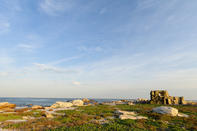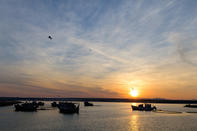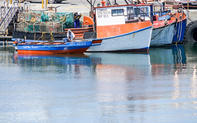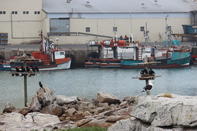A Natural Harbour
Lamberts Bay was named after Sir Robert Lambert who was the commander of the naval station at the Cape between 1820 and 1821. He was responsible for the marine survey of the south-western coast of the Cape Colony. These days the bay is most known for Bird Island, which is a small island just off the coast that is home to a large colony of sea-birds, and is also known for fishing in part due to the fact that the bay provides protection from the weather, perfectly suited to fishing boats and small trading vessels.
At the time when Lambert was the commander, the area of Lamberts Bay was part of Otterdam farm, owned by Gerrit Erasmus Smit. The site of the future town was bought in 1887 by a trader named Joseph Carl Stephan. He used the natural harbour there to use for bringing in trade goods as well as exporting wheat and other local products.
Stephan also built the Marine Hotel at the harbour. Another hotel along with a trading station was built by James William van Putten, this one further inland east of Lamberts Bay. The hotel and trading station became known as Van Puttensvlei and was the first administrative centre and police post in the area.
Anglo-Boer War

The only naval engagement of the Anglo-Boer War took place at Lamberts Bay when General Jan Smuts found a Royal Navy gunboat anchored there during his raid of the south-western Cape. Smuts’ forces opened fire on the boat from the shelter of the sand dunes, to which the boat responded with a few shells. Corporal Smallwood, a marine, was the only casualty of the encounter.
In January 1901 a British warship, the HMS Sybille, was wrecked in Lamberts Bay. After landing a naval brigade, gale force winds drove the ship 8 km south of the harbour at Steenbokfontein where it was wrecked, killing a seaman named Jones. Some items were salvaged from the wreckage and are now displayed in the Sandveld Museum. Both Jones and Smallwood are buried in the Dutch Reformed Church cemetery in Lamberts Bay.
Lamberts Bay Canning Co

After the conclusion of the Anglo-Boer War, Stephan and his brother sold some of their land at the bay to the Cape Government. The government acquired the rest of the farm in 1909. More people began settling in the area and in 1915 a school was opened. Axel Landstrom and Co. built the first crayfish factory in 1918 and also founded the Lamberts Bay Canning Co.
The Lamberts Bay Canning Co. attracted job seekers to the area and many who worked there built homes. By 1929 Lamberts Bay had become a local authority and in 1969 it achieved municipality status. After that, two other fish-canning companies attempted to enter the market but were eventually absorbed by the Lamberts Bay Canning Co.

